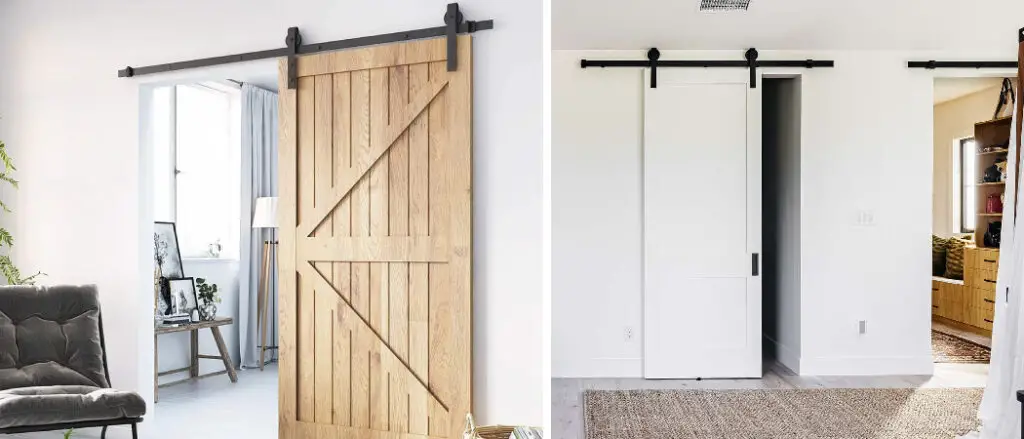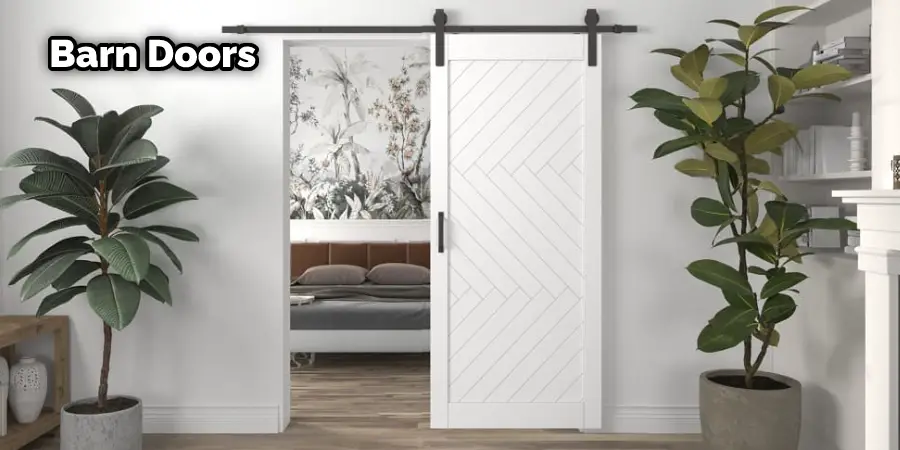Are you worried about protecting your barn and its contents from theft or other damage? While there are many measures that can be taken to secure a barn, one of the most important is installing the right locks.
Keeping your doors locked can make all the difference in keeping unwanted visitors at bay, so it’s vital that you understand how best to lock up your barn and what type of locks will work best for you.

In this blog post, we’ll explain why locking a barn door is important, different types of keyed entry systems available and provide step-by-step instructions on how to actually install and use them. With this guide as reference material, by the time you finish reading, you should feel confident enough in knowing exactly how to lock a barn door securely!
An Overview of Barn Doors
Here is an overview of the different types of barn door locks, along with their pros and cons:
- Padlocks: A padlock is a versatile and portable lock that can be used on a variety of doors, including barn doors. It can be easily removed and repositioned, making it ideal for situations where the door needs to be locked and unlocked frequently. However, padlocks can also be relatively easy to cut or pick, which means they may not provide the most secure option for locking a barn door.
- Hasps: A hasp is a metal plate that is attached to the door and provides a place for a padlock or other lock to be secured. Hasps can be used with a variety of locks and are often used in conjunction with a padlock. They can provide a high level of security, but the hasp itself can be vulnerable to attacks, such as being pried off with a crowbar.
- Deadbolts: A deadbolt is a type of lock that is installed inside the door and is typically operated with a key. Deadbolts provide a high level of security and are difficult to pick or cut. However, they can be more difficult to install than other types of locks and may require professional assistance.
- Sliding Bolt Locks: A sliding bolt lock is a simple and effective lock that is operated by sliding a bolt into a slot in the door frame. It can be used with a padlock or other locking mechanism for added security. Sliding bolt locks are relatively easy to install and can provide a moderate level of security, but they may not be as secure as other types of locks.
The type of lock that is best for a barn door will depend on a variety of factors, including the level of security needed, the frequency with which the door will be locked and unlocked, and the ease of installation.
For example, a padlock and hasp might be a good option for a barn door that needs to be locked and unlocked frequently, while a deadbolt might be a better choice for a barn door requiring a higher security level.

A sliding bolt lock might be a good option for a smaller barn door that is not frequently accessed. Ultimately, the best type of lock will depend on the specific needs of the barn and the user’s preferences.
Importance of Locking a Barning Door
Locking a barn door is important for several reasons:
- Security: A barn door that is left unlocked is vulnerable to theft and vandalism. Criminals may be tempted to steal equipment, tools, or livestock or to cause damage to the property. Owners can protect their property by locking the barn door and deter potential thieves.
- Safety: A locked barn door can also help to keep people and animals safe. Barns often contain dangerous equipment, such as saws, drills, and tractors. By locking the door, owners can prevent unauthorized access and reduce the risk of accidents or injuries.
- Privacy: Barns are often used for storage or as a workspace. By locking the door, owners can maintain their privacy and prevent others from seeing what is inside. This is especially important for businesses that may have valuable or confidential materials stored in the barn.
- Compliance: In some cases, local regulations may require barn owners to lock their doors. For example, if the barn is used to store hazardous materials, locking the door may be a legal requirement.

In summary, locking a barn door is an important step in protecting property, ensuring safety, maintaining privacy, and complying with local regulations. By taking the time to choose the right type of lock and making sure it is installed and maintained properly, owners can help to prevent theft, accidents, and other problems.
Choosing the Right Lock
When choosing the right lock for a barn door, there are several factors to consider:
- Level of security needed: The level of security needed will depend on the value of the items stored in the barn and the likelihood of theft. For example, a high-security lock such as a deadbolt may be necessary if the barn contains expensive equipment or livestock. However, a padlock or sliding bolt lock may be sufficient if the barn contains less valuable items.
- Size and style of the door: The size and style of the door will also affect the choice of lock. For example, a sliding bolt lock may be the most practical option if the door is a sliding barn door. A hasp and padlock may be a good choice for a traditional hinged door.
- Ease of installation: The ease of installation is also an important factor to consider. Some locks may require professional installation, while the barn owner can easily install others. For example, a padlock and hasp are generally easy to install, while a deadbolt may require professional assistance.
- Other security measures: It’s important to consider other security measures in addition to the lock itself. For example, adding security cameras or motion detectors may provide additional protection. In some cases, it may be necessary to add reinforcement to the door or frame to prevent forced entry.
Overall, the choice of lock will depend on the specific needs of the barn owner. It’s important to carefully evaluate the level of security needed, the size and style of the door, and the ease of installation when choosing the right lock. By taking the time to make an informed decision, barn owners can help to protect their property and deter potential thieves.
10 Step-By-Step Guide on How to Lock a Barn Door
Step 1: Choose the Right Type of Lock:
Consider the level of security needed, the size and style of the door, and the ease of installation when making your decision.
Step 2: Purchase the Hardware Necessary for Installation:
Make sure to purchase all the hardware necessary for installation, including screws and other fasteners.
Step 3: Prepare the Door:
Clean off any dirt or debris from the doorframe before installing the lock.
Step 4: Install the Lock:
Carefully follow the instructions provided with your chosen lock to install it correctly. Make sure all screws and fasteners are secure.

Step 5: Test the Lock:
Once installed, test the lock to ensure it is working properly.
Step 6: Secure any Additional Hardware:
If you have chosen a lock that requires additional hardware, such as a hasp or padlock, make sure it is installed correctly and securely.
Step 7: Lock the Door:
Once everything is in place, lock the door using your chosen lock.
Step 8: Check the Locking Mechanism Regularly:
Make sure to check the locking mechanism regularly to ensure that it is working properly.
Step 9: Replace Worn or Damaged Parts:
If any parts of the lock become worn or damaged, replacing them as soon as possible is important.
Step 10: Make sure All Keys are Kept Safely:
It is important to keep all keys securely stored and out of sight. Make sure only authorized personnel have access to the keys.
By following these steps, barn owners can help ensure that their doors are properly locked and secure. Choosing the right lock and installing it correctly can provide extra peace of mind when protecting valuable property.
How to Maintain a Barn Door Lock
Proper maintenance is key to ensuring that a barn door lock continues to work effectively over time. Here are some tips for maintaining a barn door lock:
- Keep the lock clean: Dirt and debris can build up in the lock over time, causing it to become clogged or difficult to turn. To prevent this, it’s important to keep the lock clean. Use a soft-bristled brush to remove any debris from the lock mechanism, and wipe it down with a clean cloth.
- Lubricate the lock: Over time, the lock mechanism may become dry and difficult to turn. To prevent this, apply a small amount of lubricant to the lock. Be sure to use a lubricant that is appropriate for the type of lock, as some lubricants may damage certain materials. A silicone-based lubricant is a good choice for most types of locks.
- Check for wear and tear: The lock may become worn or damaged over time. Check the lock periodically for any signs of wear or damage, such as a loose or bent locking mechanism. If you notice any problems, have the lock repaired or replaced as soon as possible.
- Troubleshoot common problems: If the lock is not working properly, there are several common problems that may be causing the issue. For example, the lock may be misaligned, the key may be worn or damaged, or the lock mechanism may be clogged with debris. If you are experiencing problems with your lock, troubleshoot the issue by checking these common causes.
- Seek professional help: If you are unable to fix the problem on your own, or if the lock is damaged beyond repair, seek professional help. A locksmith or door repair specialist can help you repair or replace the lock, ensuring it continues to work effectively over time.
By following these tips for maintaining a barn door lock, you can help ensure that it continues to work effectively over time, providing the security and peace of mind you need to protect your property.
Conclusion
Locking a barn door is important to keeping your animals and property safe. The first step in this process is to make sure you have the right type of lock for your needs, such as a deadbolt or padlock.
After that, it’s essential to install and secure the locks correctly so they can do their job properly. Finally, regular maintenance and inspection are key to ensuring that the locks remain functional over time. With these tips in mind, you should be able to keep your barn securely locked from unwanted intruders! Thanks for reading this article about how to lock a barn door.
